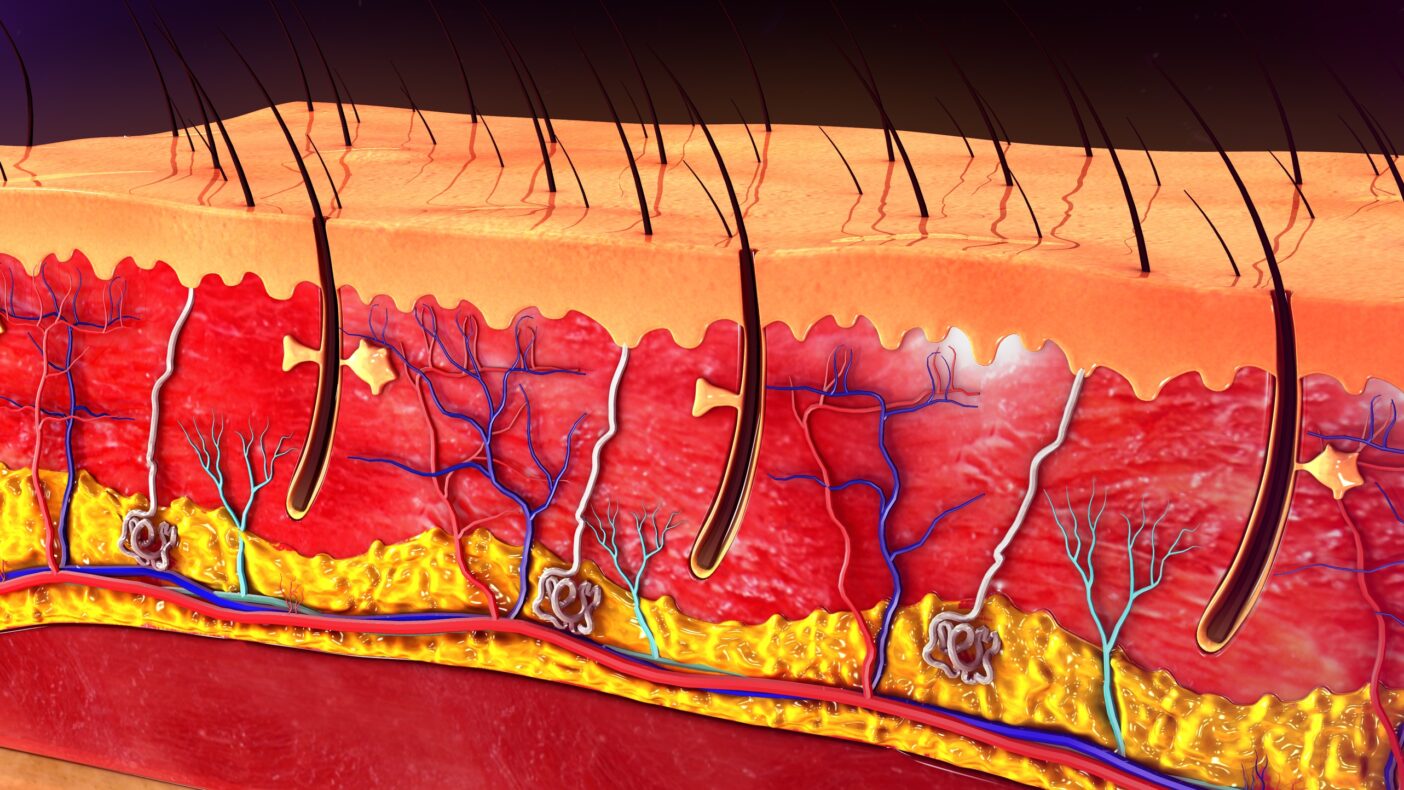Skin lipids

Skin lipids are an important group of substances that are essential for our skin to perform its functions successfully.
The protective function of the skin is performed by a horny layer, which varies in thickness depending on the area of the body, and the surface film, which consists of a water phase and a lipid phase. This film, often referred to as the acid mantle, protects the skin from drying out and, thanks to its pH value of approximately 5.5, from harmful microorganisms.
Free fatty acids such as oleic, stearic and palmitic acid, which are released from glycerides in the sebaceous glands by lipases on healthy skin, as well as endogenous lipids of epidermal origin, have an antimicrobial effect.
The important role that lipids and ceramides play in maintaining an intact skin barrier is well known.
The table below provides an overview of the composition of skin lipids in the stratum corneum:
| Lipids in the stratum corneum | Percentage by weight | Standard deviation |
|---|---|---|
| Sphingolipids | 18.2 | ±2,8 |
| Glycosylceramides | Trace | |
| Ceramides | 18.1 | ± 0,4 |
| Phospholipids | 4.9 | ± 1,6 |
| Cholesterol sulphate | 1.5 | ± 0,2 |
| Neutral lipids | 77.7 | ± 5,6 |
| Free sterols / cholesterol | 14 | ± 1,1 |
| Free fatty acids (FFAs) | 19.3 | ± 3,7 |
| Diglycerides / triglycerides | 25.2 | ± 4,6 |
| Sterol/wax esters | 5.4 | ± 0,9 |
| Squalene | 4.8 | ± 2 |
| n-Alkenes | 6.1 | ± 2,6 |
| Source: Lampe et. al 1983 |
What happens to skin lipids when the skin is cleansed?
Cleansing preparations (cleansing milk, gels, shower products, bath additives) wash away skin fats and temporarily destroy the surface film.
This also damages the cell membranes of the horny cells, which absorb more water during prolonged contact with water, causing the horny layer to swell. This loosens the cell structure and
allows microorganisms (such as bacteria or viruses) and other harmful substances to penetrate more easily into deeper layers of the skin. This effect is exacerbated by our sometimes excessive understanding of hygiene.
Not only substances known to be irritants, but also soaps, detergents and cosmetics can lead to the development of abrasion eczema. Atopic individuals are also more prone to developing eczema, which is why it is very important to protect the skin optimally from harmful influences and maintain its barrier function.
Essentially, this can be achieved by adding refatting agents (including barrier lipids) and very mild, sulphate-free surfactant systems. A cleansing milk should be used for facial cleansing.
Conclusion: skin lipids
Cosmacon can develop highly effective biomimetic cosmetic products that specifically replicate skin lipids. These natural lipids play a central role in the skin’s barrier function and moisture balance. The use of skin-identical ingredients such as ceramides, cholesterol and free fatty acids allows the development of particularly well-tolerated care formulations that effectively support the regeneration of damaged skin barriers. Whether for sensitive, dry or mature skin, tailor-made lipid complexes enable skin care that works.
Just ask Cosmacon – we develop innovative, scientifically based formulations for your brand with real added value for your customers.
In addition, our partner company, Tojo Cosmetics GmbH, has already developed a wide range of successful private label products based on biomimetic technologies.
These products are available to order immediately and offer an ideal solution for brands that want to launch high-quality skin care products quickly and without their own development costs.
Literature:
Berardesca E, Herbst R, Maibach H: Plastic occlusion stress test as a model to
investigate the effects of skin delipidization on the stratum corneum water holding
capacity in vivo. Dermatology 187: 91-94 (1993)
PMID: 8358112 German National Library+5PubMed+5PMC+5
Clarys P, Barel AO: Quantitative evaluation of skin surface lipids. Clin Dermatol
13: 307 – 321 (1995)
PMID: 6189923 ScienceDirect+4PubMed+4PubMed+4
Elias PM: Epidermal lipids, barrier function and desquamation. J Invest Dermatol
80: 44-49 (1983)
PMID: 6189923 ScienceDirect+4PubMed+4PubMed+4
Gehring W, Geier J, Gloor M: Investigations into the drying effect
of various surfactants. Dermatol Monatsschr 177: 257-264 (1991)
Gfatter R, Hackl P, Braun F: Effects of soap and detergents on skin surface pH,
stratum corneum hydration and fat content in infants. Dermatology 195: 258-262
(1997)
Haustein UF: Mechanisms of bacterial skin infections. In: Braun-Falco O,
Geiler G, Jablonska S (eds) The skin as a defence organ, Wissenschaftliche
Verlagsgesellschaft mbH, Stuttgart Halle, Chapter 3.3 p.157, (1991)
Imokawa G, Abe A, Jin K: Decreased level of ceramides in stratum corneum of
atopic dermatitis: An etiologic factor in atopic dry skin? J Invest Dermatol 96:
523-526 (1991)
Korting HC, Braun-Falco O: The effect of detergents on the skin and its
consequences. Clin Dermatol 14: 23-27
(1996)
Krunke, N: Dishidrosis, hand eczema – current picture –
accident insurance medical assessment. Medical dissertation, University of Bochum
(2001)
Lampe MA, Williams ML, Elias PM: Human epidermal lipids: characterisation
and modulations during differentiation. J Lipid Res 24: 131-40
(1983)
Lautenschläger, H: Regeneration of the skin barrier. Kosmetik International 8:
100-103 (2000)
Lautenschläger, H: Skin barrier disorders – targeted prevention. Kosmetik
International 9: 36-39 (2003)
Schürer NY, Plewig G, Elias PM: Stratum corneum lipid function.
Dermatologica 183: 77-94 (1991)
Schwanitz HJ, John SM: Occupational dermatoses. T&E Dermatol 11-12: 3-5 (1997)
Steigleder GK: Structure of the epidermis and dermis – an introduction. In:
Braun-Falco O, Geiler G, Jablonska S (eds) Die Haut als Abwehrorgan (The skin as a defence organ),
Wissenschaftliche Verlagsgesellschaft mbH, Stuttgart Halle, Chapter 2.1 pp. 2-3 (1991)
Claudia Brigitte Schrempf, dissertation ‘Hautreinigung der Haende’ (Skin cleansing of the hands), 2004